Monday, November 23, 2009
It's been a while...
There’s been a fair bit of travelling over the past couple of months, so I thought I’d share some ‘holiday snaps’ that might be of interest to paving fans, starting with the comedy pavements of Buenos Aires, as observed during the International Conference on Concrete Block Paving.
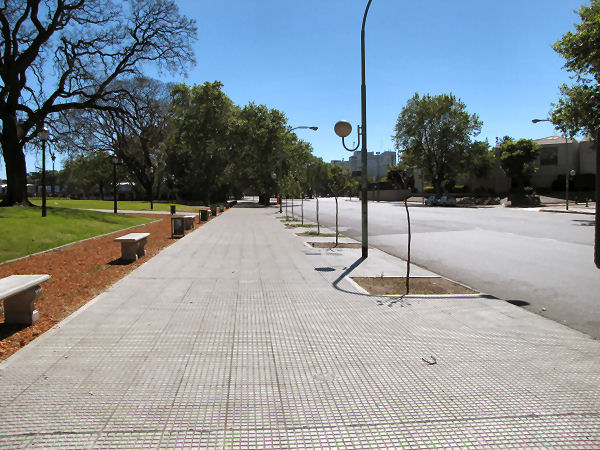
The paving of choice in the more salubrious parts of the city are these silver grey 450x450mm flags with a ‘chocolate block’ finish. This type of paving is popular in many Latin countries for reasons that escape me completely. I’ve heard arguments about enhanced drainage, enhanced traction, and even enhanced aesthetics, none of which convince, but then it would be a boring world if we all used exactly the same paving.
Putting aside the choice of paving, the actual construction and maintenance are often what determines how successful it is as a choice of surfacing and while there are some areas of the city that are well-laid and well-maintained, there are many areas where the standards of workmanship leave something to be desired.
Looking at the actual construction, they were re-laying the pavements around Cementaria Recoleta during my trip. For those not familiar with the city and its history, Cementaria Recoleta is a significant tourist attraction because it contains the mortal remain of one Eva Peron, aka Evita, or as one English student I met there put it, "Midonna". There’s a steady flow of tourists, so it’s understandable that the city government would want the pavements to be in fine fettle…
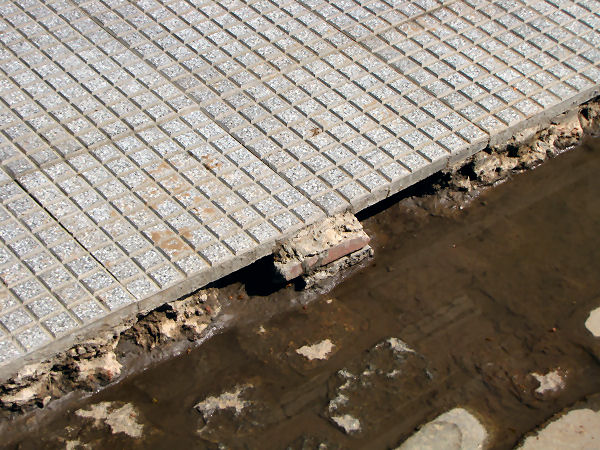
This is the edge of the new paving, where it meets the old setts. I think it would be fair to say that finishing-off is not their strong point.
And speaking of those setts, the main access road to the Cementaria has recently been re-paved using setts, and I’m guessing that the workforce has not had too much experience of that particular aspect of the trade…
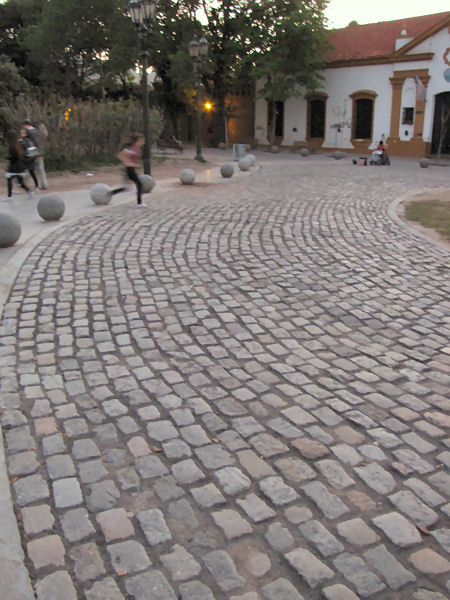
The next time I visit the city (if there is a next time!), will someone please remind me to take a straightedge with me? I reckon I could make a fortune selling them to the Highways’ Department.
Setts are not the only natural stone paving on display around the Cementaria. Outside the Chapel, they’ve re-laid the “flagstones” (and I use that term in the widest possible sense). There’s a wide range of native stone on display, along with some other ‘rocks’ that seem to have been found….
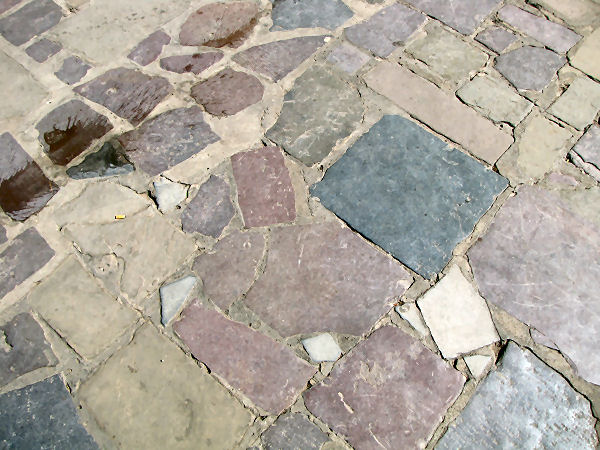
The reddish-purple stone is Porphyry, one of the native rocks for which Argentina is renowned, second only to Italy in terms of supply of this lovely paving material, and in some of the more upmarket areas of the city, the stone has been laid in its more usual format: cubes….
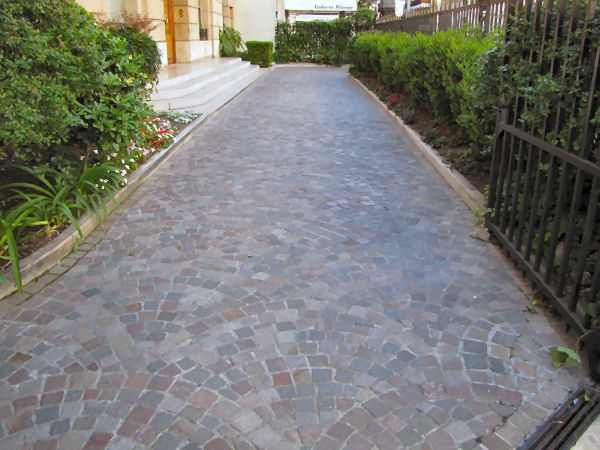
…that looks grand, doesn’t it? Porphyry setts laid as a fan pattern. The levels look fine, and there’s even an edge course, but wait a minute: those fans – there’s summat not quite right. When you look more carefully, it becomes apparent that the fans run out after a couple of metres or so and the ‘pattern’ (if I can use that term) degenerates into a sort of fan/bogen/arc mish-mash. It seems the installer started off with the general idea of laying fans but got lost or went dizzy after a an hour or two and just started dropping setts in wherever they went as long as it was vaguely arc-like and not a straight line.
Elsewhere in the city, the have managed to lay porphyry setts as attractive bogens without losing the pattern or going off-course…
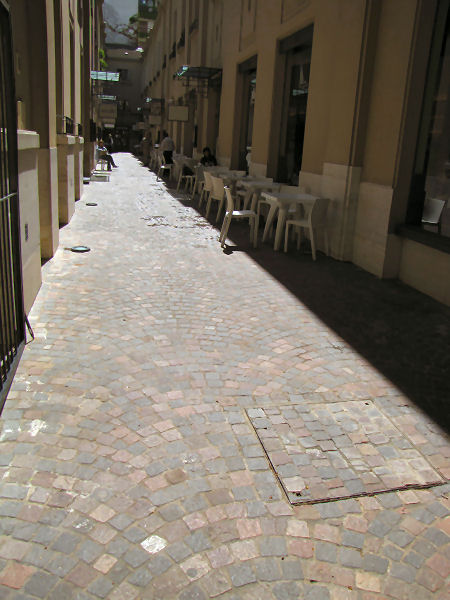
…but the concept of using recess tray covers to maintain the pattern and so mask the presence of a bloody great manhole seems to have been too much to expect!
Even so, this has to be regarded as a significant improvement on the more usual manhole covers that can be found littered around the streets and avenues…
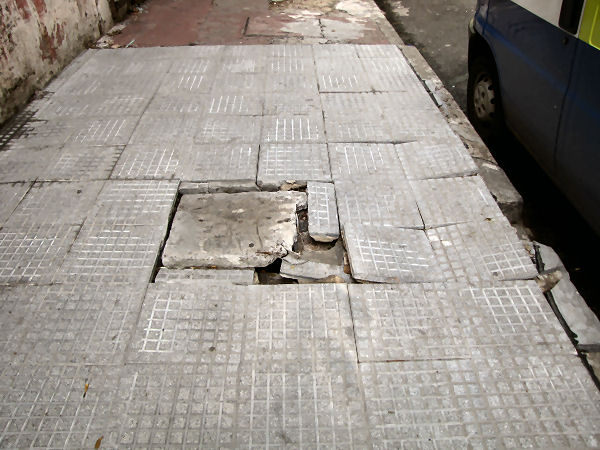
On the subject of drainage fittings, linear channels seem to be a new development. Here’s a line of them laid across the pavement across the road form the swanky Sheraton Hotel in Retiro…
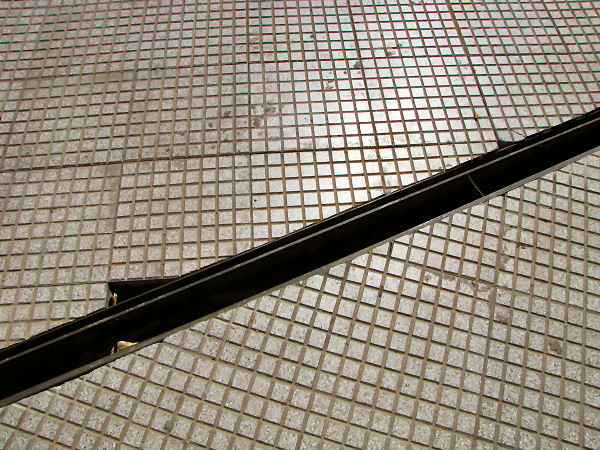
…yes: that’s a 150mm wide and 300mm deep polymer concrete linear channel, but either the local Knackers have availed themselves of the gratings as part of their weigh-in at the local scrap metal yard, or the pavement crew haven’t realised that there are gratings available to prevent the good citizens of Buenos Aires snapping their ankles when darting across the pavement from the Sheraton to the train station.
This pavement runs through a sort of square-cum-park which features a huge clock tower, once known as the “English Tower” but renamed in the aftermath of the kerfuffle over the Falklands/Malvinas. Verges and lesser-used parts of the park are dressed with an attractive orangey-red loose aggregate…
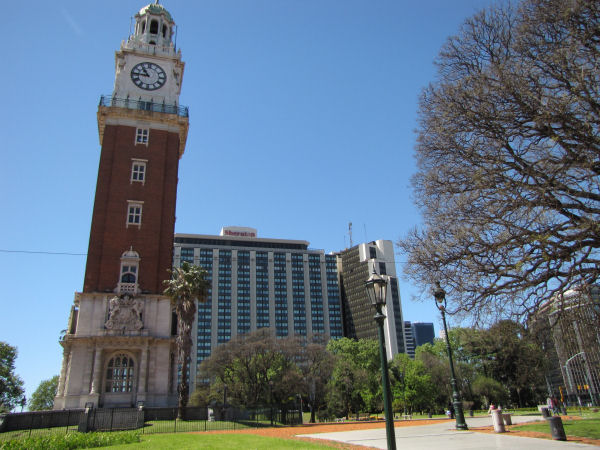

...which, on closer examination, turns out to be…...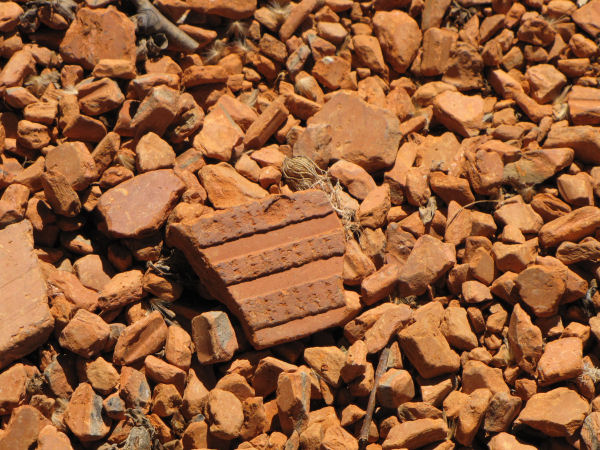
...crushed terracotta! How good is that?
All large cities rely on utilities to keep society functioning. Gas, electricity, telecoms and water are all vital to the welfare of a city, and most times, the pipes, ducts and cables that deliver these utilities are either strung up high on poles as overhead lines, or buried beneath the pavements. This is not always the case in Buenos Aires…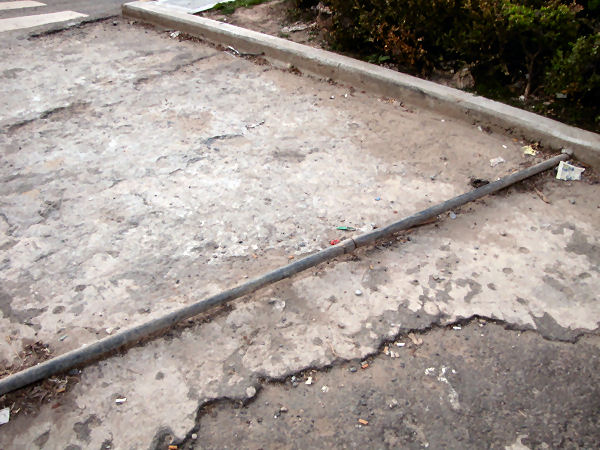
…where they occasionally run at surface level. Forget about the trip, hazard, it makes locating them so much easier, and there’s no need to dig holes to find them. However, when a hole does need to be dug, the safest way of protecting the public from falling into it, is to pile the rubble around the edges…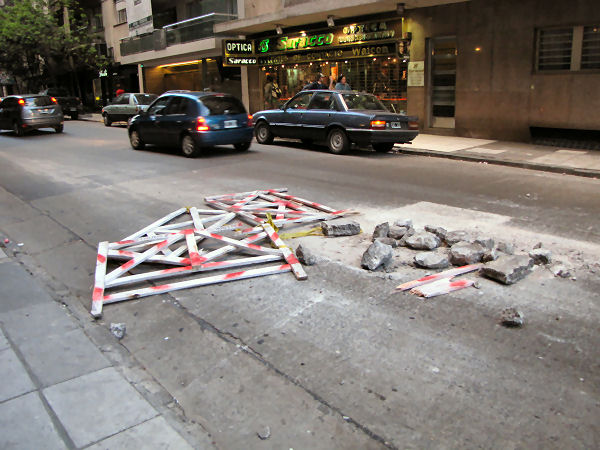
…there’s absolutely no danger then, is there?
And if you do have to dig a trench to contain the utilities, there’s no need to go made and bury them, ooh, tens of centimetres deep. It only makes them harder to find….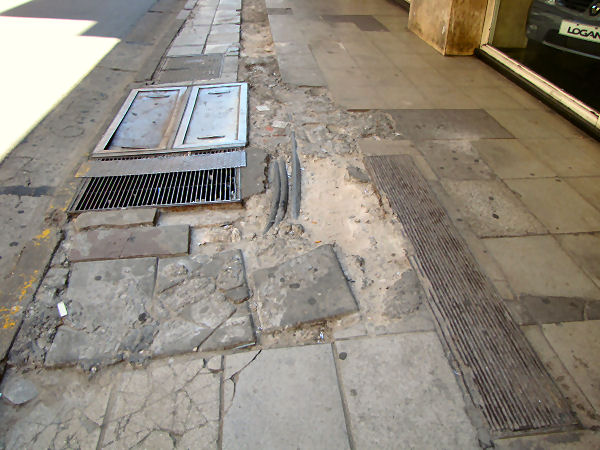
…if they are kept close to (or at) the surface, then there’s no need to waste money on those expensive CAT machines. Besides, if the services happen to be located right outside an expensive up-market car dealership, all the fancy electronic in those imported motors would probably lead to false readings. Just lay the cables in the trench and cover them over with a barrowful of quality concrete…..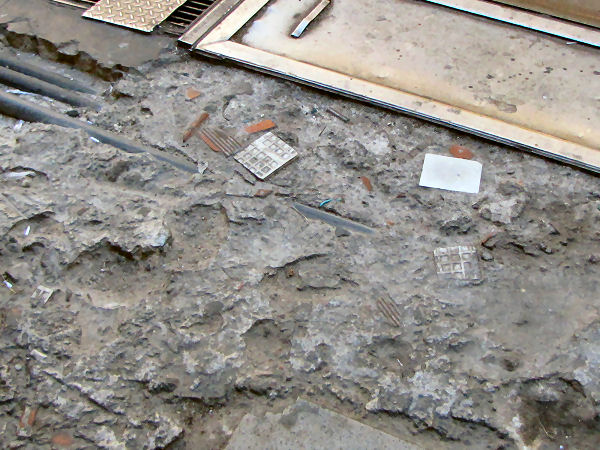
…but remember not to smooth-out the concrete too much or it might become slippery. A textured surface offers extra traction for both pedestrians and vehicles.
Sadly, some parts of the city insist on cables and pipes being properly buried beneath the pavement. But how will these completely hidden utilities be located if a repair is necessary? The more enterprising crews leave a visual marker as to the precise location of their services. See if you can spot it in this photo…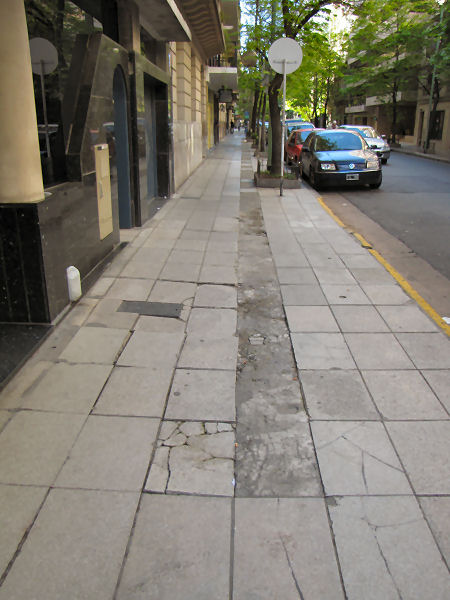
…if you’re still not sure, it’s more or less smack-bang in the centre of the footpath.
Another vexed issue with city pavements is how to manage the competing requirements of pedestrians and vehicles. The generally accepted principle is to try to keep them apart, but at some point, pedestrians will need to cross over the bits reserved for vehicles, so rather than require the noble Portenos (natives of Buenos Aires) abseil down the 300-400mm drop between footway and carriageway, a dropped crossing can be provided at key locations…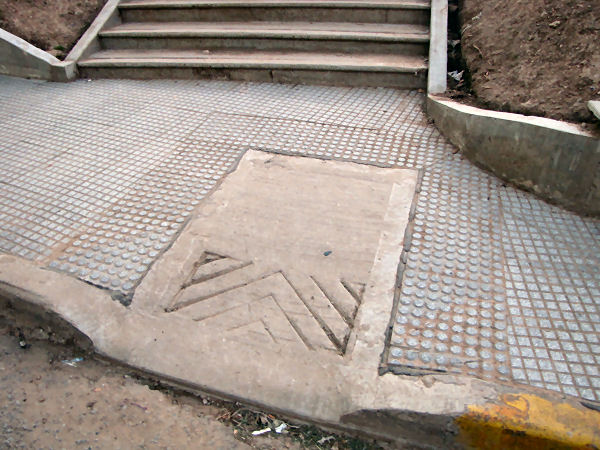
… it might not be the prettiest of dropped crossings, but it does have a form of blister paving a round the perimeter to alert the visually impaired of its presence. Not much of a contrast though, is there. What if they used a different colour for the blister tactiles? They could use a subtle shade of buff, as they do in that Europe….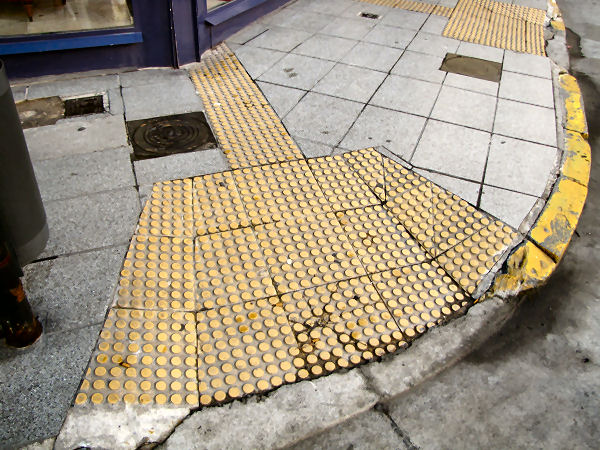
…what’s not to like?
Still, there’s a lot of work involved. If only they could come up with some form of pre-form kit that contained all necessary components and provided a professional-looking transition…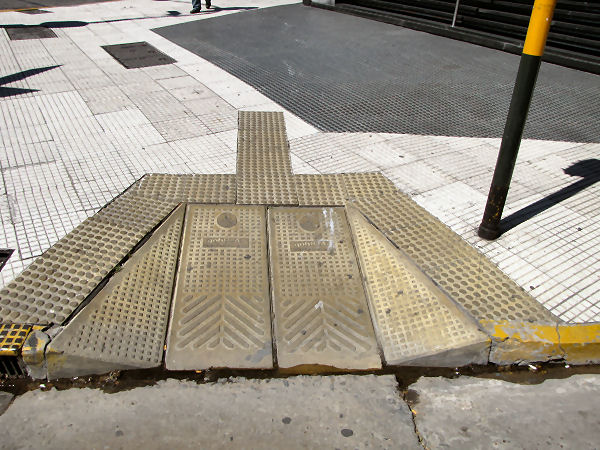
….perfect!
Actually, it’s easy to take the piss out of the paving in any city. There’s a real shocker of a tumbled CBP corner in my home town of Warrington, and we’ve all seen iffy pavements in London, Dublin, Cardiff and Edinburgh (don’t mention the Royal Mile!), so if I’ve been harsh on Buenos Aires, then I’ll finish on a positive note.
Wooden block pavers. They were used in that London in the 1840s in an attempt to reduce road noise from horse’s hooves, and while these are long gone, there are still some on show at the entrance to Trinity College at College Green in Dublin, but the largest expanse of new wood pavers I’ve ever seen is to be found in dockside La Boca, Buenos Aires….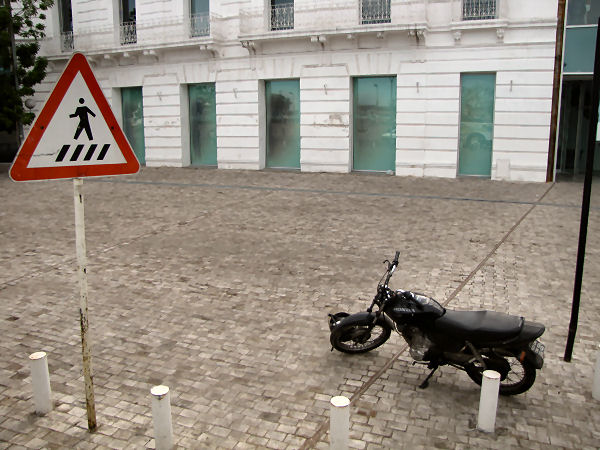
… they might look like a dirty light brown stone or concrete paver in the photie above, but they definitely *are* wooden blocks. Unfortunately, I was on an open-top tourist bus when I spotted them, so the best close-up I can manage to prove my point is….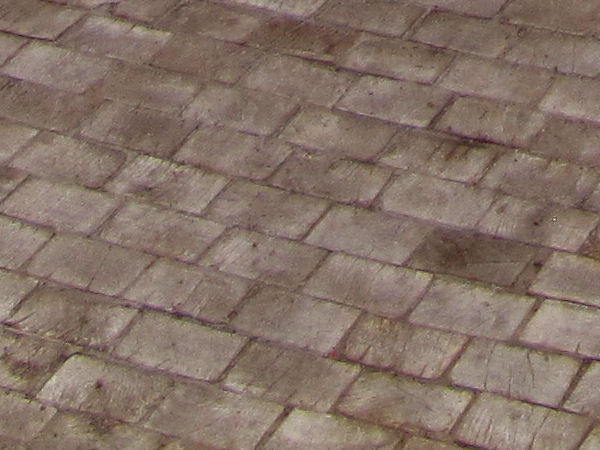
… convinced now?
Subscribe to Posts [Atom]
